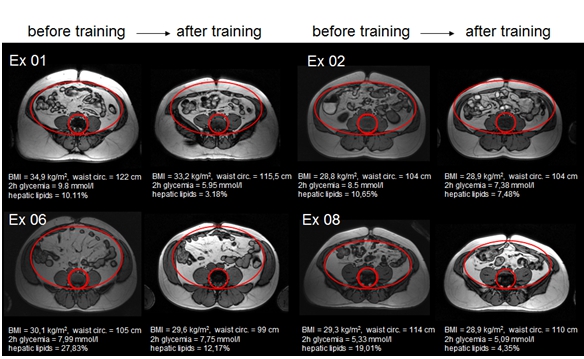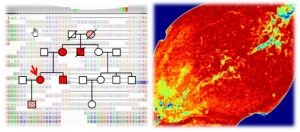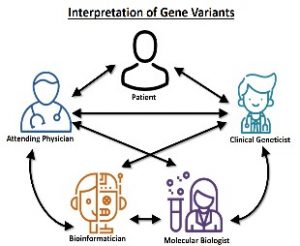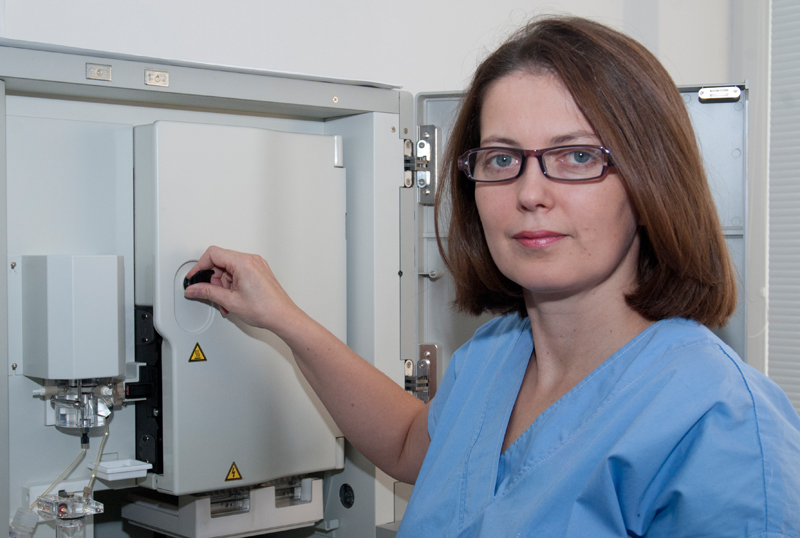Department of Metabolic Disorders
INTEGRATED PHYSIOLOGY SECTION
Obesity is an excessive accumulation of fat which develops due to the imbalance between energy intake and energy expenditure. While the energy intake – amount and quality of food – is determined by individuals` preference and environmental conditions determining food availability, energy expenditure – beyond the resting energy requirements, depending on physical fitness, age and gender – is somewhere between 1200 to 2500 kCal per day and could be targeted therapeutically.
Total daily energy expenditure could in principle be modulated by physical activity and environmental temperature. Total amount of energy we expend in 24 hours is related to the volume and dynamics of our everyday life activities. Keeping energy intake and expenditure in balance would prevent increase in body weight and minimize thus the risk of chronic metabolic as well as other chronic non-communicable diseases.
Obesity epidemics is related to the fact that physiological mechanisms protecting our energy sources are more powerful (important for the survival) than those, protecting us from an increase of body weight in obesogenic environment.
A lack of physical activity significantly contributes to the pathogenesis of many chronic diseases (“diseases from inactivity”). It is essential to understand that storing lipids within the lipid droplets of adipocytes (cells specialized to store neutral lipids) is a prerequisite for the metabolic health maintenance. Mechanisms regulating fat storage and mobilization are therefore one of the targets of our research. In fact, we study regulation of these processes in various physiological situations such as exercise (training) or cold exposure/acclimation in individuals with obesity, prediabetes or type 2. diabetes.
Regular exercise is an excellent physiological tool to prevent metabolic, cardiovascular and neurodegenerative diseases and even certain types of cancer, and it unambiguously contributes to healthy ageing.
In our work, we seek to understand some of the molecular mechanisms, contributing to neurohumoral communication of the active (contracting/trained) skeletal muscle with various distant organs, tissues and cells in our body, and to define the prerequisites for the effective adaptive processes in response to regular exercise, including regulation of skeletal muscle and adipose tissue structural, functional (hypertrophy, fiber type switch, browning) and endocrine properties.
We have designed and performed several exercise intervention studies in patients at early stages of metabolic and neurogenerative diseases aimed at inducing the complex long-term lifestyle modification and re-establishing the fragile metabolic balance (Figure 1) by increasing their physical fitness.

Figure 1. Effects of 3-month strength training on the subcutaneous and visceral abdominal adiposity in sedentary middle-aged individuals with metabolic syndrome and/or prediabetes. Determined with MRI centered at 4. and 5. LV (Ukropcová, Ukropec in Klinická obezitológia 2013).
Our work integrates exercise-induced adaptive processes in skeletal muscle and adipose tissue with the complex changes in the whole body metabolism. Explosion of the adipose tissue research related to fat cell browning (metabolic activation) is bringing incredible amounts of new information of physiological, morphological and functional determinants of adipocyte plasticity in response to regular exercise.
Another level of complexity is brought about by our efforts to translate results of our research to patient care. This effort resulted in establishing the Center of physical activity (hyperlink), providing us with the completely new research avenue fuelled by the opportunity to combine complex metabolic phenotyping with the long-term (years) follow-up of the relatively short term (months) exercise-intervention studies in individuals with chronic diseases.
Research Team

SCIENTIFIC STAFF:
prof. MUDr. Barbara Ukropcová, MD, PhD.
Mgr. Tímea Kurdiová, PhD.
Mgr. Mária Tomková, PhD.
Mgr. Patrik Krumpolec, PhD.
SCIENTIFIC AND TECHNICAL STAFF:
Bc. Katarína Cehulová
PhD STUDENTS:
Mgr. Zuzana Janáková
Mgr. Denisa Máderová
Mgr. Michal Nemec
MUDr. Martin Schön
Mgr. Lucia Slobodová
Mgr. Nicole Laiferová
Mgr. Petronela Paulová
ACTUAL PROJECTS
-
- 2017-2021 MZ-CR NV16-33746A “Skeletal muscle metabolic abnormalities in patients with idiopathic inflammatory myopathy” (Ukropcová)
-
- 2016-2020 COST Action CA15203 Mitochondrial mapping: Evolution – Age – Gender – Lifestyle – Environment (Ukropec)
-
- 2016-2020 APVV 15-0253 “Molecular mediators of physical exercise and carnosine-induced effects in patients with preclinical and early stage neurodegenerative disease” (Ukropcová)
-
- 2016-2020 APVV 15-0086 „Identification of biomarkers associated with late toxicity of chemotherapy in testicular germ cell tumors” (Ukropec)
-
- 2018-2022 VEGA 2/0107/18 “Synergistic effects of exercise and carnosine supplementation on motor functions, metabolism and skeletal muscle phenotypes in patients with early stage Parkinson’s disease.” (Ukropcová)
-
- 2017-2020 VEGA 2/0096/17 “Molecular mechanisms of human brown fat thermogenesis and its relations to obesity, physical activity and ice water swimming“ (Ukropec)
-
- 2018-2020 APVV SK-AT-2017-0025 “High-field MRS, a tool to estimate the tissue-specific metabolic state reflecting thyroid hormone activity in vivo: validation of the “virtual biopsy” clinical relevance (Ukropec)
PREVIOUS PROJECTS
-
- 2007-2011 COST FA0602 Mitofood „Bioactive Food Components, Mitochondrial Function and Health“ (Ukropec)
-
- 2008-2012 7thFP-EK „LipidomicNet“. „Lipid Droplets as Dynamic Organeles of Fat Deposition and Release: Translational Research Towards Human.” Seventh framework profram HEALTH
-
- 2007-2.1.1-6, Large Scale integrating project. (Gašperíkova/Ukropec/Ukropcová)
-
- 2011-2013 EFSD – New Horizons collaborative project „Myokines and Skeletal Muscle Plasticity in Metabolic Health and Type 2 Diabetes“ (Ukropec)
-
- 2011-2013 Investigator initiated research (IIR) grant by Pfizer, „The Effect of a Long-Term Growth Hormone Supplementation on the Whole-Body Metabolic Characteristics and Adipose Tissue Phenotype in Growth Hormone Deficient Adults: the 5-yr follow-up“ (Ukropec)
-
- 2012-2014 EFSD Lilly research fellowship „Metabolic health and muscle secretory profile in aerobic and resistance trained obese prediabetic individuals“ (Ukropcová)
-
- 2014-2015 Aktion Österreich – Slowakei, Wissenschafts und Erziehungskooperation project # 2013-10-15-0004 “Effect of exercise on pathophysiology of type 2 diabetes: Focus on magnetic resonance imaging and spectroscopy in skeletal muscle” (Ukropec)
-
- 2014-2016 SAS – NSC Joint Research Cooperation Project #2013/17„Skeletal muscle as a mediator of beneficial effects of regular exercise on cognitive functions and metabolism in patients with Alzheimer’s disease: the role of muscle myokines and microRNAs“ (Ukropcová)
-
- 2015-2017 VEGA 2/0180/15 „Studies on molecular mechanisms of cold and exercise induced metabolic activation of brown and beige adipose tissue in humans with respect to obesity and type 2. diabetes.“ (Kurdiová/Škopková)
-
- 2015-2017 VEGA – 2/0191/15 “ Učinky akútneho a pravidelného cvičenia na profil myokínov a mikroRNA v cirkulácii a v cerebrospinálnom likvore vo vzťahu ku kognitívnym funkciám a metabolizmu pacientov s neurodegeneratívnym ochorením“, (Ukropcová)
BOOK PUBLICATIONS
(current and former team members are shown in blue)
-
- UKROPCOVÁ, B – UKROPEC, J. (2013) Patofyziológia obezity. In KRAHULEC, Boris et al. Klinická obezitológia, s. 37-58. Prvé vydanie. Počet strán: 336. – Brno : Facta Medica. ISBN 978-80-904731-7-1.
-
- UKROPCOVÁ, B. – POLJAK, Z. – UKROPEC, J. (2013) Endokrinná funkcia tukového tkaniva. In KRAHULEC, Boris et al. Klinická obezitológia, s. 67-81. Prvé vydanie. Počet strán: 336. – Brno : Facta Medica. ISBN 978-80-904731-7-1.
-
- UKROPCOVÁ, B. – UKROPEC, J. (2013) Fyzická aktivita, obezita a zdravie. In KRAHULEC, Boris et al. Klinická obezitológia, s. 102-122. Prvé vydanie. Počet strán: 336. – Brno : Facta Medica. ISBN 978-80-904731-7-1.
-
- UKROPEC J., UKROPCOVÁ B. (2011) Adipose tissue and skeletal muscle plasticity in obesity and metabolic disease. In. Dyslipidemia. InTech Open Acces Publisher, Rieka, Croatia. (Eds. Roya Kelishadi), ISBN 978-953-307-726-0
-
- UKROPCOVA B, UKROPEC J, KLIMEŠ I. (2008) Endokrinný pancreas (Endocrine pancreas), Mokáň M, Martinka E, Galajda P a kol.: Diabetes mellitus a vybrané metabolické ochorenia, Vydavateľstvo P+M, Martin, Slovenská Republika. ISBN 978-809-697-139-8
SELECTED SCIENTIFIC ARTICLES
-
- KRUMPOLEC PATRIK, VALLOVA SILVIA, SLOBODOVA LUCIA, TIRPAKOVA VERONIKA, VAJDA MATEJ, SCHON MARTIN, KLEPOCHOVA RADKA, JANAKOVA ZUZANA, STRAKA IGOR, SUTOVSKY STANISLAV, TURCANI PETER, CVECKA JAN, VALKOVIC LADISLAV, TSAI CHIA LIANG., KRSSAK MARTIN, VALKOVIC PETER, SEDLIAK MILAN, UKROPCOVA BARBARA, UKROPEC JOZEF. Regular exercise improves Parkinson`s patients disability state by modulating whole- body and muscle metabolism. Front Neurol. 2017 Dec 22; 8:698.
-
- CHIA-LIANG TSAI, JOZEF UKROPEC, BARBARA UKROPCOVÁ*, MING-CHYI PAI* An acute bout of aerobic or strength exercise specifically modifies circulating exerkine levels and neurocognitive functions in elderly individuals with mild cognitive impairment. NeuroIMage Clinical 2018, 17: 272-284.
-
- HECKOVA E, POVAŽAN M, STRASSER B, KRUMPOLEC P, HNILICOVÁ P, HANGEL GJ, MOSER PA, ANDRONESI OC, VAN DER KOUWE AJ, VALKOVIC P, UKROPCOVA B, TRATTNIG S, BOGNER W. Real-time Correction of Motion and Imager Instability Artifacts during 3D γ-Aminobutyric Acid-edited MR Spectroscopic Imaging. Radiology. 2017 Sep 28:170744. doi: 10.1148/radiol.2017170744.
-
- MODICA S, STRAUB LG, BALAZ M, SUN W, VARGA L, STEFANICKA P, PROFANT M, SIMON E, NEUBAUER H, UKROPCOVA B, UKROPEC J, WOLFRUM C. Bmp4 Promotes a Brown to White-like Adipocyte Shift. Cell Rep. 2016 Aug 23;16(8):2243-58.
-
- REGAZZONI, L. – DeCOURTEN, B- GARZON, D – ALTOMARE, A – MARINELLO, C – JAKUBOVA, M – VALLOVA, S – KRUMPOLEC, P – CARINI, M – UKROPEC, J – UKROPCOVA, B* – ALDINI, G.* A carnosine intervention study in overweight human volunteers: bioavailability and reactive carbonyl species sequestering effect. Sci Reports 2016 , accepted 12.5.2016, Jun 6; 6:27224 (5.578 – IF2015)
-
- MÜLLER S*, BALAZ M*, STEFANICKA P, VARGA L, AMRI EZ, UKROPEC J, WOLLSCHEID B, WOLFRUM C. Proteomic Analysis of Human Brown Adipose Tissue Reveals Utilization of Coupled and Uncoupled Energy Expenditure Pathways. Sci Rep. 2016 Jul 15;6:30030. doi: 10.1038/srep30030.
-
- BAYE E, UKROPCOVA B, UKROPEC J, HIPKISS A, ALDINI G, *DE COURTEN B. Physiological and therapeutic effects of carnosine on cardiometabolic risk and disease. Amino Acids. 2016 May;48(5):1131-49. Review. (3.293 – IF2015)
-
- *TSAI CHIA-LIANG – PAI MING-CHYI – UKROPEC, J. *UKROPCOVÁ, B. The role of physical fitness in the neurocognitive performance of task switching in older persons with mild cognitive impairment. J Alzheimers Dis. 2016 Apr 23;53(1):143-59. (4.151 – IF2015).
-
- VALKOVIČ, L. – CHMELÍK, M. – UKROPCOVÁ, B. – HECKMANN, T. – BOGNER, W. – FROLLO, I. TSCHAN, H. – KREBS, M. – BACHL, N. – UKROPEC, J. – TRATTNIG, S. – *KRŠŠÁK, M. Skeletal muscle alkaline Pi pool is decreased in overweight-to-obese sedentary subjects and relates to mitochondrial capacity and phosphodiester content. Sci Rep. 2016 Feb 3;6:20087. (5.578 – IF2015)
-
- deCOURTEN, B. – JAKUBOVA, M. – deCOURTEN, M.P. – JUST-KUKUROVA, I – VALLOVA, S. – KRUMPOLEC, P – VALKOVIC, L – KURDIOVA, T – GARZON, D – BARBARESI, S – TEEDE, H.J. – DERAVE, W. – KRSSAK, M. – ALDINI, G – UKROPEC, J – UKROPCOVA, B. Effects of carnosine supplementation on glucose metabolism in sedentary individuals with overweight and obesity: Pilot Clinical Trial. Obesity (Silver Spring) 2016 May;24(5):1027-34 (3.734 – IF2015)
-
- JUST-KUKUROVA, I. – VALKOVIČ, L. – UKROPEC, J. – deCOURTEN, B. – CHMELIK, M. – UKROPCOVA, B. – TRATTNIG, S – KRŠŠÁK, M. Improved spectral resolution and high reliability of in vivo 1H MRS at 7T allows characterization of effect of acute exercise on carnosine in skeletal muscle. NMR Biomed 2016 Jan;29(1):24-32. (3.044 – IF2015)
-
- BEATON, N – RUDIGIER, C – MOEST, H – MUELLER, S – MROSEK, N – ROEDER, E – RUDOFSKY, G – RÜLICKE, T – UKROPEC, J – UKROPCOVA, B – AUGUSTIN, R – NEUBAUER, H – WOLFRUM, C. TUSC5 regulates insulin-mediated adipose tissue glucose uptake by modulation of GLUT4 Q6 recycling. In MOLECULAR METABOLISM – (2015) Nov 9; 4(11): 795-810 (5.360 – IF 2015).
-
- CHALLA, TD. – STRAUB, LG. – BALAZ, M. – KIEHLMANN, E. – DONZE, O. – RUDOLFSKY, G. – UKROPEC, J. – UKROPCOVA, B. – WOLFRUM, C. Regulation of de novo adipocyte differentiation through crosstalk between adipocytes and pre-adipocytes. In Diabetes. 2015 Sep 4. Pii:db 141932. (8.095 – IF2014).
-
- BALAZ, M. – UKROPCOVA, B. – KURDIOVA, T. – GAJDOSECHOVA, L. – VLCEK, M. – JANAKOVA, Z. – FEDELES, J. – PURA, M. – GASPERIKOVA, D. – SMITH, SR. – TKACOVA, R. – KLIMES, I. – PAYER, J. – WOLFRUM, C. – UKROPEC, J. Adipokine zinc-α2-glycoprotein regulated by growth hormone and linked to insulin sensitivity. Obesity. 2015 Feb;23(2):322-8. (4.389 – IF2013).
-
- KURDIOVA, T. – BALAZ, M. – MAYER, A. – MADEROVA, D. – BELAN, V. – WOLFRUM, Ch. – UKROPEC, J. – UKROPCOVA, B. Exercise-mimicking Treatment Fails to Increase Fndc5 mRNA & Irisin Secretion in Primary Human Myotubes. Peptides. 2014, 56:1-7. (2.614 – IF2013).
-
- VALKOVIČ, L. – CHMELÍK, M. – JUST KUKUROVÁ, I. – JAKUBOVÁ, M. – KIPFELSBERGER, M.C.- KRUMPOLEC, P. – TUŠEK JELENC, M.- BOGNER, W – MEYERSPEER, M. – UKROPEC, J. – FROLLO, I. – UKROPCOVÁ, B. – TRATTNIG, S. – KRŠŠÁK, M. Depth-resolved surface coil MRS (DRESS)-localized dynamic (31) P-MRS of the exercising human gastrocnemius muscle at 7 T. NMR Biomed. 2014 Nov;27(11):1346-52. (3.559 – IF2013)
-
- BALAZ M, – VICIAN M, – JANAKOVA Z, – KURDIOVA T, – SUROVA M, – IMRICH R, – MAJERCIKOVA Z, – PENESOVA A, – VLCEK M, – KISS A, – BELAN V, – KLIMES I, – OLEJNIK J, – GASPERIKOVA D, – WOLFRUM C, – UKROPCOVA B, – UKROPEC J. Subcutaneous adipose tissue zinc-α2-glycoprotein is associated with adipose tissue and whole-body insulin sensitivity. Obesity (Silver Spring). 2014 Aug;22(8):1821-9. (4.389 – IF2013),
-
- KURDIOVA T., BALAZ M., VICIAN M., MADEROVA D., VLCEK M., VALKOVIC L., SRBECKY M., IMRICH R., KYSELOVICOVA O., BELAN V., JELOK I., WOLFRUM C., KLIMES I., KRSSAK M., ZEMKOVA E., GASPERIKOVA D., UKROPEC J., UKROPCOVA B.: Are Skeletal Muscle & Adipose Tissue Fndc5 Gene Expression and Irisin Release Affected by Obesity, Diabetes and Exercise? In vivo & in vitro studies. In The Journal of Physiology (London), 2014 Mar 1;592(Pt 5):1091-107 (IF2012 – 4.38)
-
- MROSEK N, – MEISSBURGER B, – MATAKI C, – ROEDER E, – UKROPEC J, – KLIMES I, – GASPERIKOVA D, – NAWROTH PP, – RUDOFSKY G, – AUWERX J, – SCHOONJANS K, – WOLFRUM C. Transcriptional regulation of adipocyte formation by the liver receptor homologue 1 (Lrh1)-Small hetero-dimerization partner (Shp) network. Mol Metab. 2013 Mar 16;2(3):314-23. doi: 10.1016/j.molmet.2013.03.003. (5,360 – IF 2015).
-
- KRISHNAN, J. – DANZER, C. – SIMKA, T. – UKROPEC, J. – WALTER, K.M. – KUMPF, S. – MIRTSCHINK, P. – UKROPCOVA, B. – GASPERIKOVA, D. – PEDRAZZINI, T. – KREK W. (2012) Dietary obesity-associated Hif1α activation in adipocytes restricts fatty acid oxidation and energy expenditure via suppression of the Sirt2-NAD+ system. Genes Dev. 2012 Feb 1;26(3):259-70. (IF 2010 = 13.892)
-
- VARGOVIČ, Peter – UKROPEC, Jozef – LAUKOVÁ, Marcela – KURDIOVÁ, Timea – BALÁŽ, Miroslav – MANZ, B. – UKROPCOVÁ, Barbara – KVETŇANSKÝ, Richard. Repeated immobilization stress induces catecholamine production in rat mesenteric adipocytes. In Stress : the international journal on the biologie of stress, 2013, vol.16, n. 3, pp. 340-352. (3.252 – IF2012). ISSN 1025-3890.
-
- POBEHA P., UKROPEC J., SKYBA P., UKROPCOVA B., JOPPA P., KURDIOVA T., JAVORSKY M., KLIMES I., TKAC I., GASPERIKOVA D., TKACOVA R. (2011) Relationship between osteoporosis and adipose tissue leptin and osteoprotegerin in patients with chronic obstructive pulmonary disease. Bone; 48(5):1008-14. (IF 2010 = 4.601)
-
- UKROPEC J., RADIKOVA Z., HUCKOVA M., KOSKA J., KOCAN A., SEBOKOVA E., DROBNA B., TRNOVEC T., SUSIENKOVA K., LABUDOVA V., GASPERÍKOVA D., LANGER P., KLIMES I. (2010) High Prevalence of Prediabetes and Diabetes in a Population Exposed to High Levels of an Organochlorines Cocktail, Diabetologia; 53(5):899-906. (IF 2010 = 6,973)
-
- UKROPEC J., PENESOVÁ A., SKOPKOVÁ M., PURA M., VLCEK M., RÁDIKOVÁ Z., IMRICH R., UKROPCOVÁ B., TAJTÁKOVÁ M., KOSKA J., ZÓRAD S., BELAN V., VANUGA P., PAYER J., ECKEL J., KLIMES I., GASPERÍKOVÁ D. (2008) Adipokine protein expression pattern in growth hormone deficiency predisposes to the increased fat cell size and the whole body metabolic derangements. J Clin Endocrinol Metab.; 93(6):2255-62. (IF 2007 = 5,493)
-
- SKOPKOVÁ M., PENESOVÁ A., SELL H., RÁDIKOVÁ Z., VLCEK M., IMRICH R., KOSKA J., UKROPEC J., ECKEL J., KLIMES I., GASPERÍKOVÁ D. (2007) Protein array reveals differentially expressed proteins in subcutaneous adipose tissue in obesity. Obesity (Silver Spring); 15(10):2396-406. (IF 2006 = 4,38)
-
- UKROPEC J., ANUNCIADO R.V., RAVUSSIN Y., HULVER M.W., KOZAK L.P. (2006) UCP1-independent thermogenesis in white adipose tissue of cold-acclimated Ucp1-/- mice. J Biol Chem.; 281(42):31894-908. (IF 2005 = 5,328)
-
- UKROPEC J., ANUNCIADO R., RAVUSSIN Y., KOZAK L.P. (2006) Leptin is required for uncoupling protein-1-independent thermogenesis during cold stress. Endocrinology.; 147(5):2468-80. (IF 2005 = 4,996)
-
- UKROPEC J, RESELAND JE, GAŠPERÍKOVÁ D, DEMČÁKOVÁ E, MADSEN L, BERGE RK, RUSTAN AC, KLIMES I, DREVON CA, ŠEBÖKOVÁ E (2003): The hypotriglyceridemic effect of n-3 FA is associated with increased beta oxidation and reduced leptin expression. Lipids 38: 1023-1029. (IF2003 = 2,164)
-
- MEISSBURGER B., UKROPEC J., ROEDER E., BEATON N., GEIGER M., TEUPSER D., CIVAN B., LANGHANS W., NAWROTH P.P., GASPERIKOVA D., RUDOFSKY G., WOLFRUM C. (2011) Adipogenesis and insulin sensitivity in obesity are regulated by retinoid-related orphan receptor gamma. EMBO Mol Med; 3(11):637-51. (IF 2010 = 8,833)
-
- SPARKS LM, UKROPCOVA B, SMITH J, PASARICA M, HYMEL D, XIE H, BRAY GA, MILES JM, SMITH SR. Relation of adipose tissue to metabolic flexibility. Diabetes Res Clin Pract. 2009 Jan;83(1):32-43.
-
- CIVITARESE AE, UKROPCOVA B, CARLING S, HULVER M, DEFRONZO RA, MANDARINO L, RAVUSSIN E, SMITH SR: Role of adiponectin in human skeletal muscle bioenergetics. Cell Metab 2006 Jul;4(1):75-87 IF=16,75
-
- UKROPCOVA B, SEREDA O, DE JONGE L, BOGACKA I, NGUYEN T, XIE H, BRAY GA, SMITH SR: Family history of diabetes links impaired substrate switching and reduced mitochondrial content in skeletal muscle.Diabetes2007Mar;56(3):720-7 IF=8,47
-
- CIVITARESE AE , CARLING S, HEILBRONN LK , HULVER MH, UKROPCOVA B, DEUTSCH WA, SMITH SR, RAVUSSIN E: Calorie restriction increases muscle mitochondrial biogenesis in healthy humans. PLOS Medicine 4 (3): 485-494 MAR 2007 IF=14,0
-
- UKROPCOVA B, MCNEIL M, SEREDA O, LEVITAN L, HUI XIE, BRAY GA, SMITH SR: Dynamic changes in fat oxidation in human primary myocytes mirror metabolic characteristics of the donor. J Clin Invest. 2005 Jul;115(7):1934-41 IF=15,05
-
- BOGACKA I, UKROPCOVA B, MCNEIL M, GIMBLE JM, SMITH SR: Structural and functional consequences of mitochondrial biogenesis in human adipocytes in vitro. J. Clin. Endocrinol Metab; 2005 Dec;90(12):6650-6 IF=6,3
Department of Metabolic Disorders
SECTION ON HUMAN GENETICS
The Section on Human Genetics of the Department of Metabolic Diseases is dedicated to the research of rare diseases with focus on monogenic diabetes, congenital hyperinsulinism, monogenic obesity, primary mitochondriopathies and sensorineural hearing loss. The research is conducted in close cooperation with National Institute of Children Diseases, University Hospital and Medical Faculty of Comenius University in Bratislava, Slovakia and outpatients’ endocrinologists, diabetologists, pediatricians, neonatologists, othorinolaryngologists throughout whole Slovakia.

The main goal of our research is: a) up-to-date DNA analysis (real-time PCR, Sanger sequencing, panel resequencing using iSeq system, whole exome sequencing including bioinformatics analysis); b) phenotype-genotype correlation including functional studies of novel identified variants; c) translation of results into the clinical praxis based on the pharmacogenetics approach.

In summary, the goal of our research is to obtain new theoretical knowledge about the etiopathogenesis of studied diseases and to apply the results into the clinical praxis subsequently.
Brief description of the studied disorders:
A: Monogenic diabetes is a rare type of diabetes caused by a mutation in a single gene. It differs from Type 1 or Type 2 diabetes (polygenic disorders) and requires genetic testing for an accurate diagnosis and treatment. Monogenic diabetes is a heterogenous disease and can be divided into two main categories, namely permanent neonatal diabetes and MODY (Maturity Onset Diabetes of the Young).
Permanent Neonatal Diabetes Mellitus (PNDM) is a type of diabetes with onset within the first 6 months of life and persists throughout the lifespan. Mutations in KATP channel genes (ABCC8 and KCNJ11) are the most common cause of neonatal diabetes mellitus. Mutations in these genes cause PNDM by preventing closure of pancreatic KATP channels in response to increased glucose concentration. This results in insulin deficiency, which historically has required treatment with replacement doses of insulin. However, in majority of affected individuals, sulfonylurea treatment can bypass the genetic defect by binding SUR1 and closing pancreatic KATP channels. This promota secretion of endogenous insulin and allows patients to stop insulin injections and achieve excellent glycemic control and better quality of life. Sulfonylureas are the optimum treatment for KCNJ11-PNDM in long term; in patients who successfully transfer from insulin to sulfonylureas, metabolic control is maintained in >90% for at least 10 years with no serious adverse effects.
The second main category of monogenic diabetes is Maturity Onset Diabetes of the Young (MODY). where disruptions in several genes have already been described as the cause.Three subtypes are the most prevalent. GCK-MODY, clinically characterized by fasting hyperglycemia without apparent worsening with aging and low risk for chronic vascular complications, is caused by inactivating mutations in the glucokinase gene. Most of the people with GCK-MODY do not require any pharmacotherapy. Disruption of transcription factors hepatocyte nuclear factor 1-alpha (HNF1A-MODY) or 4-alpha (HNF4A-MODY) leads to a progressive form of diabetes with a high risk of vascular complications and a requirement for pharmacological treatment later in life. Patients with these two types of diabetes can also benefit from the insulin-secretion stimulating sulphonylurea therapy, as their beta-cell insulin production is maintained years after disease onset.
Syndromic monogenic diabetes could be present in individuals suspected to have MODY. The most prevalent causes of such diagnosis are disruption of the HNF1B gene leading to Renal Cysts And Diabetes (RCAD) known also as HNF1B-MODY and Mitochondrial Inherited Diabetes mellitus and Deafness (MIDD) caused by mutations in mtDNA (mainly m. 3243A>G).
B: Congenital hyperinsulinism is most commonly caused by mutations in the KCNJ11, ABCC8, GCK, and HNF4A genes, which have a role in insulin secretion. Hyperinsulinism manifests early after birth with severe hypoglycaemia, which can damage brain function with the development of lifelong consequences (mental retardation or motor impairment). The choice of effective treatment directly depends on identification of the exact genetic cause.
C: Monogenic forms of obesity account for about 5% of patients with severe obesity. The development of obesity in these patients occurs in the first year of life, often reaching the severe degree with early development of serious complications. Mutations in the leptin, leptin receptor, MC4 receptor, SIM1 and POMC genes are the most commonly studied.
D: Primary mitochondriopathies are a clinically and genetically heterogeneous group of inherited diseases that arise due to a defect in energy metabolism in the mitochondria. Once the most common causes of mitochondrial dysfunction have been ruled out, further diagnosis remains routinely unavailable to the patient. The aim of this research is to identify and further characterize rare causes of mitochondriopathies in patients in Slovakia using next-generation sequencing techniques.
E: Sensorineural hearing loss is the most common sensory disorder in humans, with genetic factors playing an important role in its etiology. Direct sequencing allows identification of the causative gene only in a minority of cases. In about 2/3 of cases of familial deafness, the causative gene remains unidentified. The aim of the research is to identify new, previously unknown gene variants. Due to the huge genetic heterogeneity of this disorder, next-generation sequencing methods are applied.
Research and translation to clinics
In frame of our projects, we provide the DNA testing and expert analysis for patients with above mentioned diagnoses all over Slovakia. We actively participate in yearly external quality assessments scheme for molecular genetics diagnostics of monogenic diabetes (2008-until now) and hearing impairment (2012-until now) conducted by EMQN.
We are active in studies related to epidemiology and pharmacogenetics of neonatal diabetes. We have established the incidence of permanent neonatal diabetes in Slovakia based on the Childhood Diabetes Registry, which was unique. The incidence of permanent neonatal diabetes in Slovakia is much higher (1 out of 215 417 born children) than was assumed by international clinical observations (1: 800 000). Consequently, these data were supported by the results of other Childhood Diabetes Registries in Europe. Moreover, we have actively participated in the switch from insulin to sulphonylurea treatment in the patients with permanent neonatal diabetes and their long-term follow-up.
The first DNA biobank founded, supervised and maintained by our team was the biobank for monogenic diabetes testing, which includes >1500 patients from >700 families, currently. The functional studies related to the function of the HNF1A gene (transactivation luciferase assay, DNA binding, nuclear localisation) and to study the impact of variants on splicing (mini-gene assay) have been established to help to assess the pathogenicity of variants of unknown significance found in the patients. Additionally, we actively participate in international ClinGen Monogenic Diabetes Expert Panel Group working on guidelines for variant interpretation.
The DNA biobanks for the other disorders include currently > 1000 families with hearing impairment, >60 families with hyperinsulinism, >90 families with suspected mitochondriopathy, and >600 patients with obesity. In selected cases, specific in vitro functional studies have been performed. The clinicians wishing to collaborate on our studies can find information and download necessary documents on our www.diabgene.sk page.
Research Team

BIO
MSc. in Biochemistry (1992), PhD. in Animal Physiology (1998), Dr. rer. Nat in Molecular Biology (2014), DSc. In Genetics (2015)
Since 2013: Head of Laboratory of Diabgene at the Institute of Experimental Endocrinology, Slovak Academy of Sciences, Bratislava, Slovakia
Since 2017: Scientific Director, Institute of Experimental Endocrinology, Biomedical Research Center, Slovak Academy of Sciences, Bratislava, Slovakia
Major research interests
- Monogenic forms of insulin secretion and action
- Monogenic obesity
- Primary mitochondriopahties
- Hereditary hearing loss
Awards
Guoth Price of the Slovak Medical Society (2003)
Price of the European Endocrine Society (2007)
Razus lecture awarded by Slovak Diabetes Society (2009)
Member of excellent research team according to ARRA agency (2010)
Prices of the Slovak Diabetes Association for best publications in the years (2012 – 2018)
Price for Science and Technique 2018 in the category best scientific team (2018)
PRINCIPAL INVESTIGATORS:
doc. MUDr. Juraj Staník, PhD.
RNDr. Martina Škopková, PhD.
MUDr. RNDr. Lukáš Varga, PhD.
EMERITUS:
prof. MUDr. Iwar Klimeš, DrSc. † (professor Emeritus) – founder of Laboratory of Metabolic Disorders, head of Department of Metabolic Disorders (1992 – 2007), former director of Institute of Experimental Endocrinology SAS (2007 – 2013)
SCIENTIFIC STAFF:
RNDr. Silvia Borecká, PhD.
Mgr. Dominika Hromníková, PhD.
MUDr. Daniela Staníková, PhD.
Mgr. Terézia Valkovičová, PhD.
SCIENTIFIC AND TECHNICAL STAFF:
RNDr. Miroslava Hučková
PhD STUDENTS:
RNDr. Zuzana Dobiašová
MSc. Vibhuti Rambani
Mgr. Marek Sklenár
DIPLOMANTI:
Bc. Klaudia Cipková
Filip Greguš
TECHNICIANS:
Alica Mitková
Current projects:
2018-2022: APVV 17-0296 HYPOMITGEN – GENETIC CAUSES OF RARE DISEASES WITH EMPHASIS ON METABOLIC DISORDERS ASSOCIATED WITH HYPOGLYCEMIA AND MITOCHONDIOPATHIES (Gašperíková)
2021-2025: APVV 20/0239 SYNDEAF – IDENTIFICATION OF NOVEL GENETIC VARIANTS IN SYNDROMIC HEARING LOSS BY WHOLE EXOME SEQUENCING (Gašperíková)
2019-2022 MZ SR 2019/2020 – LFUK-8 – COMPREHENSIVE INNOVATIVE DIAGNOSTICS AND PERSONALIZED TREATMENT OF DIABETES MELLITUS IN CHILDREN (Gašperíková)
2021-2024: VEGA 2/0131/21 GENETICS OF RARE FORMS OF DIABETES WITH FOCUS ON FUNCTIONAL CHARACTERIZATION OF NEW VARIANTS (Škopková)
2021-2024: VEGA 1/0572/21 IDENTIFICATION OF ETIOLOGY IN SPORADIC FORMS OF HEREDITARY HEARING LOSS BY WHOLE EXOME SEQUENCING (Gašperíková)
2022-2025: VEGA 1/0659/22 RESEARCH ON CLINICAL AND GENETIC ASPECTS OF KETOTIC HYPOGLYCAEMIA IN CHILDREN (Gašperíková)
2020-2023 ŠF EÚ BIOFORD – GENETICS OF RARE FORMS OF DIABETES WITH FOCUS ON FUNCTIONAL CHARACTERIZATION OF NEW VARIANTS (Gašperíková)
PUBLICATIONS (current and former team members are in blue)
Rambani V, Hromnikova D, Gasperikova D, Skopkova M.: Mitochondria and mitochondrial disorders: an overview update. Endocr Regul. 2022 Jul 13;56(3):232-248. doi: 10.2478/enr-2022-0025. PMID: 35843711 Free article.
Tijardović M, Štambuk T, Juszczak A, Keser T, Gasperikova D, Novokmet M, Tjora E, Pape Medvidović E, Stanik J, Rasmus Njølstad P, Lauc G, Owen KR, Gornik O.: Fucosylated AGP glycopeptides as biomarkers of HNF1A-Maturity onset diabetes of the young. Diabetes Res Clin Pract. 2022 Mar;185:109226. doi: 10.1016/j.diabres.2022.109226. Epub 2022 Feb 2.PMID: 35122907 Free article.
Brennerová K, Škopková M, Ostrožlíková M, Šaligová J, Staník J, Bzdúch V, Gašperíková D.: Genetic testing is necessary for correct diagnosis and treatment in patients with isolated methylmalonic aciduria: a case report. BMC Pediatr. 2021 Dec 16;21(1):578. doi: 10.1186/s12887-021-03067-3.PMID: 34915869 Free PMC article.
Pavlenkova Z, Varga L, Borecka S, Karhanek M, Huckova M, Skopkova M, Profant M, Gasperikova D. Comprehensive molecular-genetic analysis of mid-frequency sensorineural hearing loss. Sci Rep. 2021 Nov 18;11(1):22488. doi: 10.1038/s41598-021-01876-1. PMID: 34795337 Free PMC article.
Safka Brozkova D, Uhrova Meszarosova A, Lassuthova P, Varga L, Staněk D, Borecká S, Laštůvková J, Čejnová V, Rašková D, Lhota F, Gašperíková D, Seeman P. The Cause of Hereditary Hearing Loss in GJB2 Heterozygotes-A Comprehensive Study of the GJB2/DFNB1 Region.Genes (Basel). 2021 May 1;12(5):684. doi: 10.3390/genes12050684. PMID: 34062854 Free PMC article.
Varga L, Danis D, Drsata J, Masindova I, Skopkova M, Slobodova Z, Chrobok V, Profant M, Gasperikova D. Novel variants in EDNRB gene in Waardenburg syndrome type II and SOX10 gene in PCWH syndrome. Int J Pediatr Otorhinolaryngol. 2021 Jan;140:110499. doi: 10.1016/j.ijporl.2020.110499. Epub 2020 Nov 13. PMID: 33234331
Bowman P, Mathews F, Barbetti F, Shepherd MH, Sanchez J, Piccini B, Beltrand J, Letourneau-Freiberg LR, Polak M, Greeley SAW, Rawlins E, Babiker T, Thomas NJ, De Franco E, Ellard S, Flanagan SE, Hattersley AT; Neonatal Diabetes International Collaborative Group (including Gasperikova D and Stanik J). Long-term Follow-up of Glycemic and Neurological Outcomes in an International Series of Patients With Sulfonylurea-Treated ABCC8 Permanent Neonatal Diabetes. Diabetes Care. 2021 Jan;44(1):35-42. doi: 10.2337/dc20-1520. Epub 2020 Nov 12. PMID: 33184150 Free PMC article.
Hulín J, Škopková M, Valkovičová T, Mikulajová S, Rosoľanková M, Papcun P, Gašperíková D, Staník J. Clinical implications of the glucokinase impaired function – GCK MODY today. Physiol Res. 2020 Dec 22;69(6):995-1011. doi: 10.33549/physiolres.934487. Epub 2020 Nov 2. PMID: 33129248 Free PMC article. Review.
Stanik J, Barak L, Dankovcikova A, Valkovicova T, Skopkova M, Gasperikova D. Comparison of diabetes phenotype in children and their mothers with permanent neonatal diabetes mellitus carrying the same KCNJ11 variants. Endocr Regul. 2020 Nov 24;54(4):260-265. doi: 10.2478/enr-2020-0029. PMID: 33885251 Free article.
Trochanová I, Staníková D, Škopková M, Haštová K, Gašperíková D, Staník J, Čižnár P. Immunologic phenotype of a child with the MEHMO syndrome. Physiol Res. 2020 Nov 16;69(5):927-932. doi: 10.33549/physiolres.934498. Epub 2020 Sep 9. PMID: 32901502 Free PMC article.
Stanik J, Barak L, Dankovcikova A, Valkovicova T, Skopkova M, Gasperikova D. Diabetes treatment in two pregnant women with permanent neonatal diabetes mellitus due to a KCNJ11 mutation. Diabet Med. 2020 Nov;37(11):1956-1958. doi: 10.1111/dme.14363. Epub 2020 Jul 20. PMID: 32634858
Safka Brozkova D, Varga L, Uhrova Meszarosova A, Slobodova Z, Skopkova M, Soltysova A, Ficek A, Jencik J, Lastuvkova J, Gasperikova D, Seeman P. Variant c.2158-2A>G in MANBA is an important and frequent cause of hereditary hearing loss and beta-mannosidosis among the Czech and Slovak Roma population- evidence for a new ethnic-specific variant. Orphanet J Rare Dis. 2020 Aug 26;15(1):222. doi: 10.1186/s13023-020-01508-3. PMID: 32847582 Free PMC article.
Varga L, Danis D, Skopkova M, Masindova I, Slobodova Z, Demesova L, Profant M, Gasperikova D. Novel EYA4 variant in Slovak family with late onset autosomal dominant hearing loss: a case report. BMC Med Genet. 2019 May 17;20(1):84. doi: 10.1186/s12881-019-0806-y. PMID: 31101089 Free PMC article.
Valkovicova T, Skopkova M, Stanik J, Gasperikova D. Novel insights into genetics and clinics of the HNF1A-MODY. Endocr Regul. 2019 Apr 1;53(2):110-134. doi: 10.2478/enr-2019-0013. PMID: 31517624 Free article. Review.
Kolnikova M, Jungova P, Skopkova M, Foltan T, Gasperikova D, Mattosova S, Chandoga J. Late Infantile Metachromatic Leukodystrophy Due to Novel Pathogenic Variants in the PSAP Gene. J Mol Neurosci. 2019 Apr;67(4):559-563. doi: 10.1007/s12031-019-1259-7. Epub 2019 Jan 11. PMID: 30632081
Varga L, Jovankovicova A, Huckova M, Demesova L, Gasperikova D, Sebova I, Profant M. Hereditary bilateral sudden sensorineural hearing loss. Bratisl Lek Listy. 2019;120(9):699-702. doi: 10.4149/BLL_2019_118. PMID: 31475558
Bowman P, Sulen Å, Barbetti F, Beltrand J, Svalastoga P, Codner E, Tessmann EH, Juliusson PB, Skrivarhaug T, Pearson ER, Flanagan SE, Babiker T, Thomas NJ, Shepherd MH, Ellard S, Klimes I, Szopa M, Polak M, Iafusco D, Hattersley AT, Njølstad PR; Neonatal Diabetes International Collaborative Group (including Gasperikova D and Stanik J). Effectiveness and safety of long-term treatment with sulfonylureas in patients with neonatal diabetes due to KCNJ11 mutations: an international cohort study. Lancet Diabetes Endocrinol. 2018 Aug;6(8):637-646. doi: 10.1016/S2213-8587(18)30106-2. Epub 2018 Jun 4. PMID: 29880308 Free PMC article.
Stanik J, Skopkova M, Stanikova D, Brennerova K, Barak L, Ticha L, Hornova J, Klimes I, Gasperikova D. Neonatal hypoglycemia, early-onset diabetes and hypopituitarism due to the mutation in EIF2S3 gene causing MEHMO syndrome. Physiol Res. 2018 May 4;67(2):331-337. doi: 10.33549/physiolres.933689. Epub 2018 Jan 5. PMID: 29303605 Free article.
Danis D, Brennerova K, Skopkova M, Kurdiova T, Ukropec J, Stanik J, Kolnikova M, Gasperikova D. Mutations in SURF1 are important genetic causes of Leigh syndrome in Slovak patients. Endocr Regul. 2018 Apr 1;52(2):110-118. doi: 10.2478/enr-2018-0013. PMID: 29715184 Free article.
Department of Metabolic Disorders
CELLULAR AND MOLECULAR METABOLISM SECTION
Our research is focused on investigation of molecular mechanisms, which control the energy metabolism of fat, skeletal muscle, and liver cells, and mediate the crosstalk between these metabolically active tissues. We are searching for new strategies to increase their metabolic activity, with a primary aim to promote energy expenditure and improve metabolic health of human. Nowadays, we are facing obesity pandemic, which affects life quality and health of more than one billion people worldwide, as it leads to development of severe chronic disorders such as type 2 diabetes, non-alcoholic steatohepatitis, or cardiovascular disease.
We are particularly interested in (i) investigation of brown adipose tissue and alternative thermogenic mechanisms, as well as in (ii) elucidating the pathogenesis of non-alcoholic steatohepatitis at the level of individual cell types and populations. For investigation of cellular metabolism, we utilize cell lines, mouse models, genetic and pharmacological tools, and state-of-the art techniques, such as next-generation RNA sequencing, metabolomic analysis, CRISPR-Cas9 gene editing, which allow us to study metabolic processes at the level of individual molecules. We are interested also in their role in regulation of physiological processes at the level of complex organism.
Our research is based on long-term and very productive collaborations with clinical partners from Faculty of Medicine and University hospital of Comenius University in Bratislava, and with top research teams abroad (ETH Zürich, Switzerland), which allow us to investigate mechanisms relevant for human on cellular and genetic mouse models, with potential to apply our findings in clinical praxis.
Our long-term goal is to identify novel therapeutic strategies for treatment of obesity and associated metabolic disease.
Research Team

Lucia Balazova obtained a doctoral degree in Animal Physiology at the Faculty of Natural Sciences of Comenius University in Bratislava (2015). Subsequently, she worked for 6 years as a postdoctoral researcher at the Swiss Federal Institute of Technology, ETH Zürich. She has been involved in the identification of several molecular mechanisms that control the metabolic activity of adipose tissue. The results of her work were published in prestigious scientific journals, including Nature, Nature Medicine, Cell Metabolism, Nature Communications or Nature Metabolism. Currently, she investigates molecular mechanisms regulating cellular energy metabolism with the aim of exploiting their potential to treat metabolic diseases such as diabetes, obesity and metabolic dysfunction associated steatotic liver disease.
She was awarded by the Scientist of the year 2021 award in the category Young Investigator (SCSTI, SAS, ZSVTS. She was awarded by Young investigator award 2014 (FEPS), Scientist of the Slovak republic 2021 in the category Young investigator) and Talent of BMC SAS 2023 (BMC SAS).
Web of Science ResearcherID: Y-6371-2019
WOS: https://www.webofscience.com/wos/author/record/48602585
PRINCIPAL INVESTIGATOR:
Mgr. Miroslav Baláž, PhD.; Web of Science ResearcherID: E-8034-2018, WOS: https://www.webofscience.com/wos/author/record/1073066, ORCID: https://orcid.org/0000-0002-5740-4896
SCIENTIFIC STAFF:
Mgr. Zuzana Kovaničová, PhD.
Mgr. Zuzana Vince Kážmérová, PhD.
Mgr. Lívia Petrisková, PhD.
PhD STUDENTS:
Mgr. Natália Pálešová
Mgr. Alžbeta Jančovičová
Mgr. Matúš Antal
CURRENT PROJECTS
2022 – 2025: SASPRO2 (Lucia Balážová, 1260/02/02) – Marie Sklodowska-Curie COFUND, Horizon 2020; Investigating the role of GPR180/CTHRC1 signalling in regulation of pancreatic beta cell function and pathogenesis of diabetes
2022 – 2025: SASPRO2 (Miroslav Baláž, 1148/01/02) – Marie Sklodowska-Curie COFUND, Horizon 2020; Lactate, a metabolic signal and energy fuel driving alternative thermogenic mechanisms
2023 – 2027: APVV (Lucia Balážová, APVV–22–0310) – Uncovering the surfaceome and cargo of hepatic extracellular vesicles to identify circulating NAFLD biomarker
2023 – 2027: APVV (Miroslav Baláž, APVV-22-0291) Elucidating the molecular mechanisms and metabolic regulation of substrate cycles
2023 – 2026: VEGA (Lucia Balážová, VEGA 2/0128/23) The role of GPR180 in regulation of pancreatic ß cell function and pathogenesis of diabetes
2023 – 2026: VEGA (Miroslav Baláž VEGA 2/0102/23 Lactate, a metabolic signal and energy fuel for alternative thermogenic mechanisms
MOST RELEVANT PUBLICATIONS (TOP 5)
Balazova L, Balaz M, Horvath C, Horváth Á, Moser C, Kovanicova Z, Ghosh A, Ghoshdastider U, Efthymiou V, Kiehlmann E, Sun W, Dong H, Ding L, Amri EZ, Nuutila P, Virtanen KA, Niemi T, Ukropcova B, Ukropec J, Pelczar P, Lamla T, Hamilton B, Neubauer H, Wolfrum C. GPR180 is a component of TGFβ signalling that promotes thermogenic adipocyte function and mediates the metabolic effects of the adipocyte-secreted factor CTHRC1. Nature Communications, 2021; 12(1): 7144. IF 17.6
Balaz M, Becker AS, Balazova L, Straub L, Müller J, Gashi G, Maushart CI, Sun W, Dong H, Moser C, Horvath C, Efthymiou V, Rachamin Y, Modica S, Zellweger C, Bacanovic S, Stefanicka P, Varga L, Ukropcova B, Profant M, Opitz L, Amri EZ, Akula MK, Bergo M, Ukropec J, Falk C, Zamboni N, Betz MJ, Burger IA, Wolfrum C*. Inhibition of Mevalonate Pathway Prevents Adipocyte Browning in Mice and Men by Affecting Protein Prenylation. Cell Metabolism, 2019; 29(4): 901-916.e8. IF 21.5
Sun W, Dong H, Balaz M, Slyper M, Drokhlyansky E, Colleluori G, Giordano A, Kovanicova Z, Stefanicka P, Balazova L, Ding L, Husted AS, Rudofsky G, Ukropec J, Cinti S, Schwartz TW, Regev A, Wolfrum C. snRNA-seq reveals a subpopulation of adipocytes that regulates thermogenesis. Nature, 2020; 587: 98-102. IF 49.9
Dong H, Sun W, Shen Y, Balaz M, Balazova L, Ding L, Löffler M, Hamilton B, Klöting N, Blüher M, Neubauer H, Klein H, Wolfrum C. Identification of a regulatory pathway inhibiting adipogenesis via RSPO2. Nature Metabolism, 2022; 4(1): 90-105. IF 19.8
Efthymiou V, Ding LG, Balaz M, Sun W, Balazova L, Straub LG, Dong H, Simon E, Ghosh A, Perdikari A, Keller S, Ghoshdastider U, Horvath C, Moser C, Hamilton B, Neubauer H, Wolfrum C. Inhibition of AXL receptor tyrosine kinase enhances brown adipose tissue functionality in mice. Nature Communications. 2023; 14(1): 4164, IF 16.6







